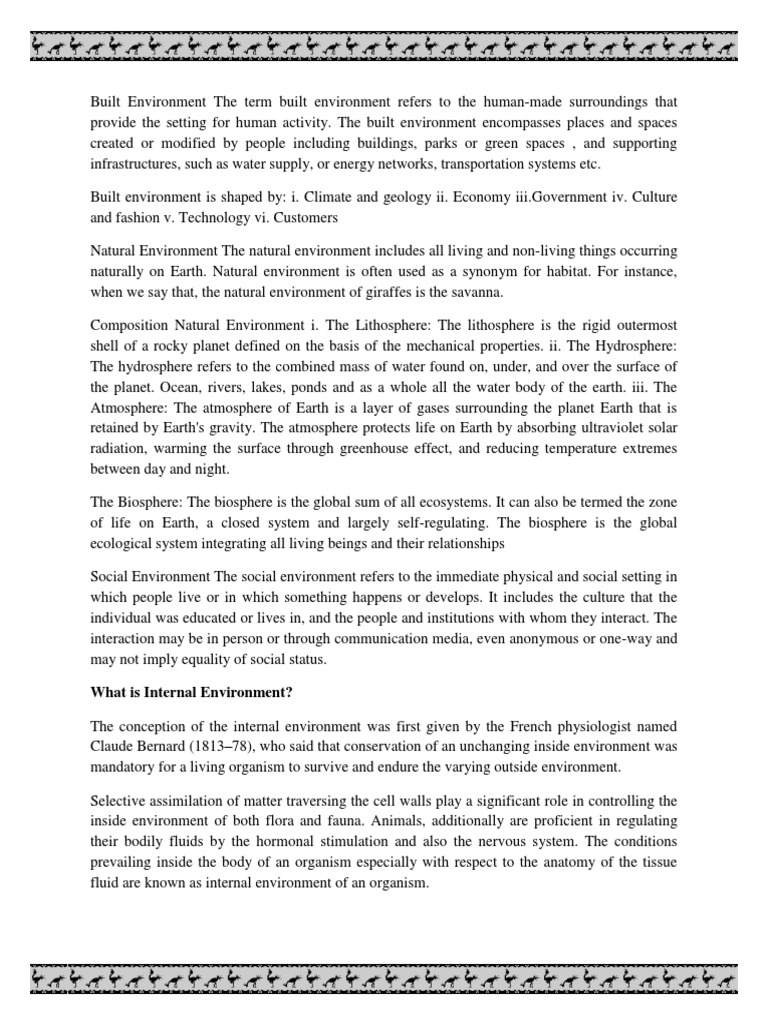The concept of the built environment is multifaceted, intricately woven into both human geography and the broader tapestry of environmental studies. As societies evolve, so too do the physical spaces they inhabit, leading to profound implications on ecological footprints, social interactions, and cultural expressions. But what exactly does the term “built environment” encapsulate? Could it be said that our surroundings shape us just as much as we shape them? This interplay prompts an intriguing contemplation on the ramifications of our constructed habitats.
To commence, the built environment refers to the human-made settings in which we live, work, and play. This encompasses not only buildings and infrastructure—such as bridges and roads—but also public spaces, neighborhood designs, and even urban landscapes. Essentially, anything altered or created through human agency contributes to this term. Therefore, when exploring the built environment, one must consider how these creations affect human behavior, societal norms, and even environmental sustainability.
In human geography, the built environment serves as a critical lens through which researchers analyze the dynamics between space and social, economic, and political processes. The influence of urban planning on the distribution of resources, demographic shifts, and cultural practices becomes evident in various case studies. Cities exemplify this relationship, where the arrangement of streets and facilities directs daily activities and social interactions.
Moreover, the built environment can significantly influence public health. Urban planners are increasingly cognizant of how accessible green spaces, walkable neighborhoods, and transportation options contribute to the well-being of residents. For instance, consider the challenge of food deserts—areas lacking adequate access to affordable and nutritious food. Poor architectural choices or infrastructural neglect can perpetuate these hardships, illustrating the gravity of intentional design and planning in fostering healthier communities.
One may ask: how can altering the built environment address climate change? This question is paramount, for the construction and operation of buildings worldwide contribute substantially to greenhouse gas emissions. From the materials used to the energy consumption patterns, every decision in the creation of our environments bears consequences for the planet. Therefore, the concept of sustainability becomes inextricably linked to the built environment, as the need for resilience in the face of climate change intensifies.
Historically, human geography has illuminated the dichotomy between rural and urban environments, yet both present distinct challenges and opportunities. In urban areas, the focus often shifts to density and resource allocation. Cities must innovate to manage population growth while minimizing their carbon footprint. High-rise buildings, for instance, can optimize space but may escalate energy demands if not designed sustainably.
Conversely, rural built environments face different but equally pressing issues. Infrastructure development can often lag behind urban trends, leading to challenges in access and service delivery. Expanding transportation networks and broadband connections in remote areas can bridge gaps while also encouraging economic growth and resource accessibility. Yet, these developments must be executed with caution to minimize their impact on natural landscapes.
Central to both urban and rural discussions is the principle of environmental justice. Accessibility and equity must be core considerations when designing built environments. Marginalized communities are frequently disproportionately affected by environmental degradation, as they may lack the political clout or financial means to advocate for better living conditions. Urban planners and decision-makers must therefore endeavor to foster inclusivity, ensuring that all community voices are heard and factored into developmental strategies.
The relationship between the built environment and social capital is another essential aspect to explore. Architectural designs can promote a sense of community and belonging, or alternatively, they may isolate individuals and foster social fragmentation. For instance, the design of public parks and communal spaces can cultivate social interactions, while poorly designed neighborhoods may inhibit connectivity among residents. This connection between spatial design and social outcomes invites meaningful discussions about the importance of empathy in urban planning.
Furthermore, the integration of technology within the built environment raises questions about the future of human geography. Smart cities—centers leveraging data and technology for enhanced living experiences—are becoming more commonplace. However, this technological advancement must be approached critically. Can cities become overly automated to the point of excluding human experience? Striking a balance between innovation and community needs is a vital consideration for sustainable urban futures.
As we look ahead, the intersection of climate change and the built environment presents a formidable challenge. What changes must be made to ensure our environments are not only adaptable to but also resilient against the impacts of climate change? Cities must evolve through innovative designs that prioritize energy efficiency, utilize renewable resources, and foster ecological habitats within urban centers. These adaptations not only mitigate climate impacts but also enhance the quality of life for inhabitants.
In conclusion, the built environment is more than a backdrop against which human activities unfold; it is a dynamic entity that shapes our lives and reflects societal values. Understanding its impact through the lens of human geography can lead to a more sustainable and inclusive future. The inquiry into how we design our spaces goes beyond aesthetics; it raises fundamental questions about equity, health, and environmental stewardship. As we consider the built environment, let us challenge ourselves: how can we reimagine our constructed spaces to support both human flourishing and ecological integrity?
